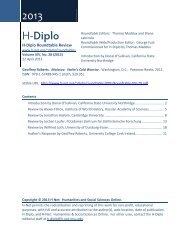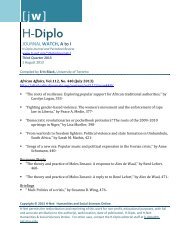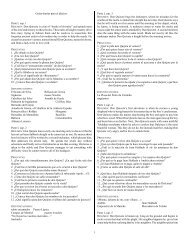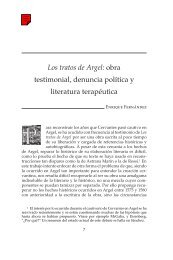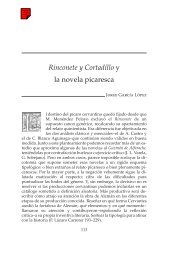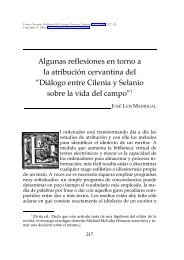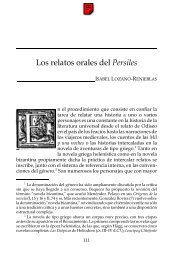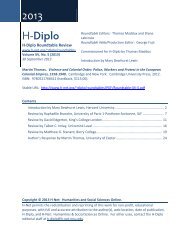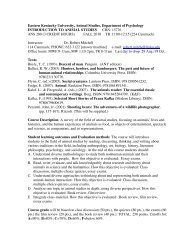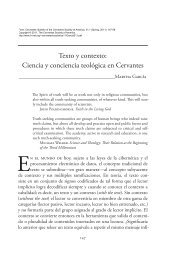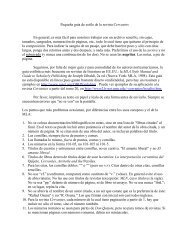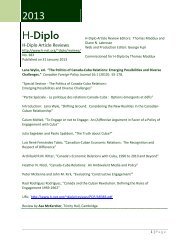The Function of Skepticism in Part I of Don Quijote - H-Net
The Function of Skepticism in Part I of Don Quijote - H-Net
The Function of Skepticism in Part I of Don Quijote - H-Net
Create successful ePaper yourself
Turn your PDF publications into a flip-book with our unique Google optimized e-Paper software.
Volume 30.2 (2010) <strong>The</strong> <strong>Function</strong> <strong>of</strong> <strong>Skepticism</strong><br />
121<br />
ments <strong>in</strong> the story accomplish: given that it is difficult if not impossible<br />
to ascerta<strong>in</strong> the truth or the falsehood <strong>of</strong> the story based on authority, the<br />
reader is forced to reject authority as a valid pr<strong>in</strong>ciple <strong>of</strong> argumentation.<br />
This entails <strong>in</strong> turn that the only th<strong>in</strong>g left is the story itself. Regardless <strong>of</strong><br />
whether the story has authority or not, we have no alternative but to read<br />
about <strong>Don</strong> <strong>Quijote</strong>. This is important from the perspective <strong>of</strong> skepticism<br />
because if we simply read the story, then we will observe <strong>Don</strong> <strong>Quijote</strong> as<br />
the story unfolds. In other words, no appeal to authority is needed because<br />
the only th<strong>in</strong>g the reader has to do is to read the story.<br />
It should be noted that <strong>in</strong> this analysis the relationship between <strong>Part</strong><br />
I and authority has been discussed from a very limited perspective: the<br />
perspective <strong>of</strong> skepticism as a method to establish truth. If, however, we<br />
expand the use <strong>of</strong> authority to <strong>in</strong>clude other uses, then the relationship<br />
becomes more complex.<br />
Literary critics tend to view the question <strong>of</strong> authority from the perspective<br />
<strong>of</strong> mimesis and literary models. For example, Frederick de Armas<br />
associates the giant Goliath, who is mentioned <strong>in</strong> the prologue, with several<br />
traditions, or models:<br />
Although Eduardo Urb<strong>in</strong>a (1987) and Agustín Redondo (1998)<br />
rightly search for models <strong>of</strong> Cervant<strong>in</strong>e imitation <strong>in</strong> the chivalric romances,<br />
the prologue <strong>of</strong> <strong>Don</strong> Quixote makes it clear that there are<br />
other traditions <strong>of</strong> giants, the biblical and the classical. (2006, 43) 9<br />
Carolyn A. Nadeau explores the women mentioned <strong>in</strong> the prologue<br />
<strong>in</strong> order to illum<strong>in</strong>ate the k<strong>in</strong>d <strong>of</strong> imitation used most frequently by<br />
matically, <strong>in</strong> accord with the customs and laws one perceives but without mak<strong>in</strong>g any judgment<br />
as to their absolute truth or falsehood” (1982, 14).<br />
9 Frederick de Armas also writes the follow<strong>in</strong>g: “An <strong>in</strong>nkeeper is compared to Cacus <strong>in</strong> the<br />
second chapter <strong>of</strong> <strong>Part</strong> I, while the size <strong>of</strong> Goliath is discussed <strong>in</strong> the first chapter <strong>of</strong> <strong>Part</strong> II us<strong>in</strong>g<br />
the bible as authority.” (2006, 43). <strong>The</strong> giant Cacus is not be<strong>in</strong>g used as a means towards establish<strong>in</strong>g<br />
the truth <strong>of</strong> the story, but as a comparison. On the other hand, even though the existence<br />
<strong>of</strong> Goliath is supported with an appeal to authority, that use is <strong>in</strong> <strong>Part</strong> II, and therefore it falls<br />
outside <strong>of</strong> the parameters <strong>of</strong> this study. I suspect strongly that the relationship between authority<br />
and skepticism changes <strong>in</strong> <strong>Part</strong> II, but that change cannot be covered here.



